Java集合
集合: 对象的容器,定义了对多个对象进行操作的常用方法。可实现数组的功能。
- 和数组的区别
- 数组长度固定,集合长度不固定
- 数组可以存储基本类型和引用类型,集合只能存储引用类型
Collection集合
Collection集合由List和Set组成。Collection,List,Set都是接口,具体方法由ArrayList,HashSet等实现类实现。
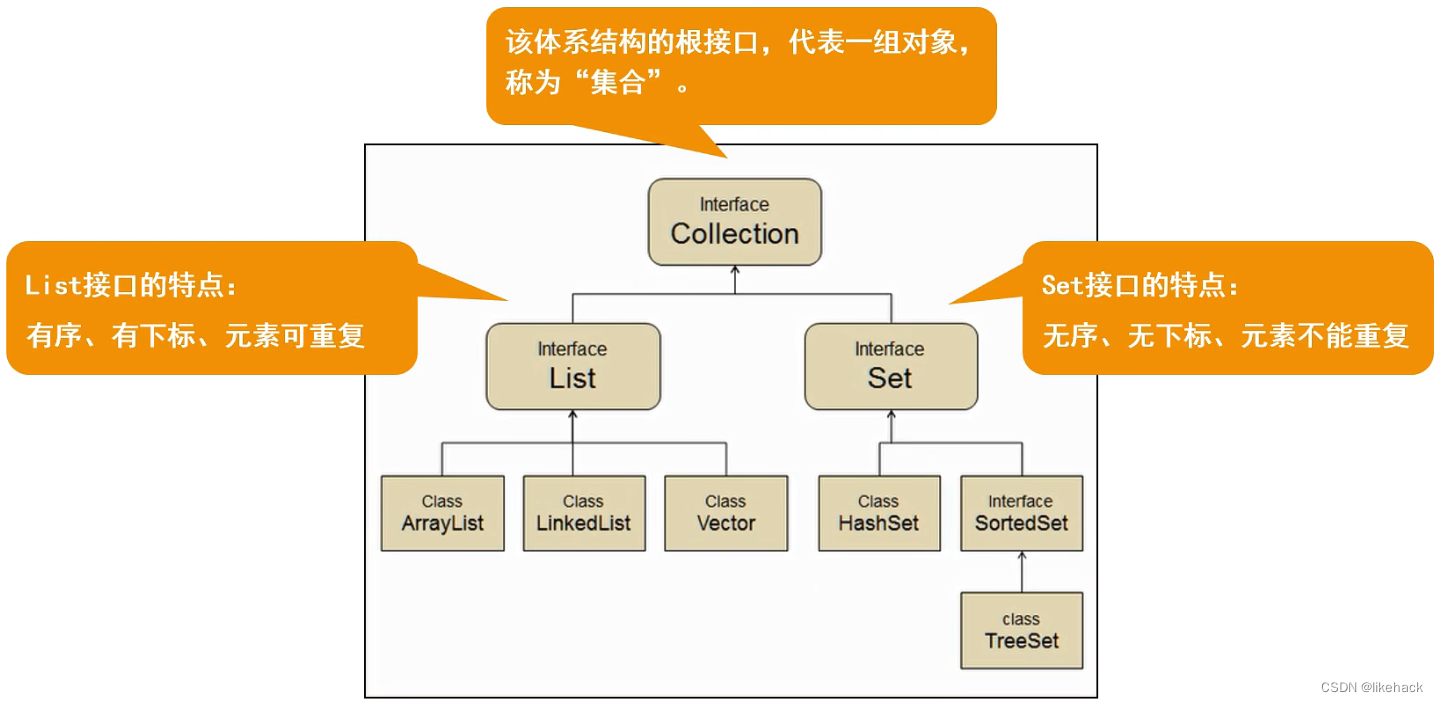
Collection接口:
常用方法:
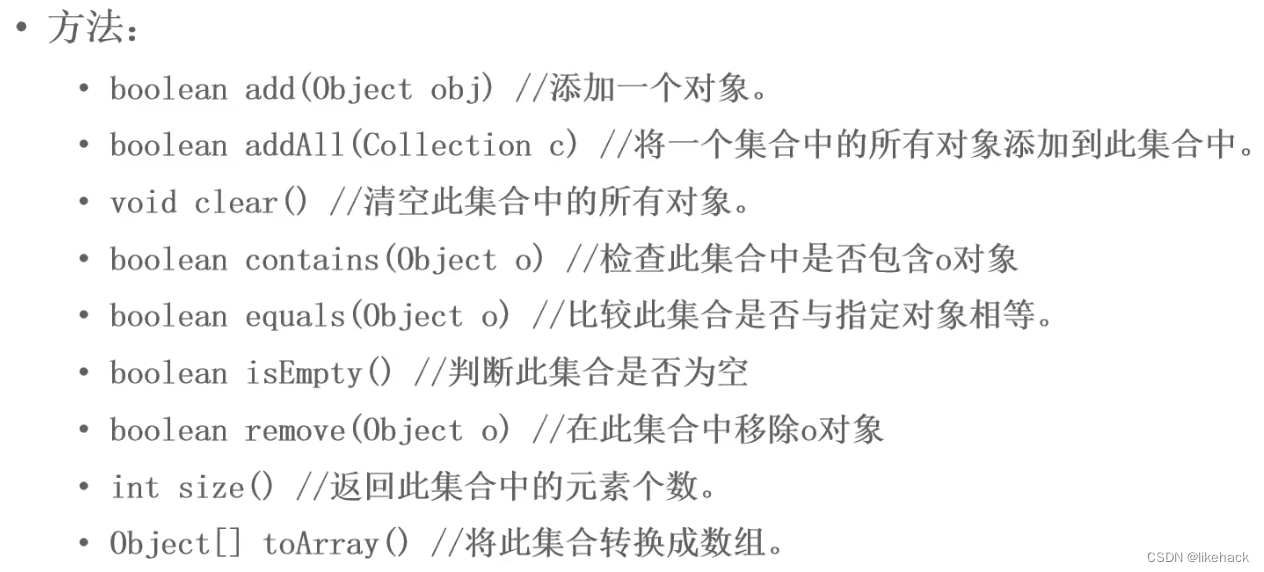
案例
使用ArrayList实现Colleciton接口,存储String类型数据
public class testCollectionSet {
public static void main(String[] args) {
//创建集合
Collection collection=new ArrayList();
addElement(collection);
traverseElement(collection);
judgeElement(collection);
deleteElement(collection);
}
//判断
private static void judgeElement(Collection collection) {
System.out.println(collection.contains("西瓜"));
System.out.println(collection.isEmpty());
System.out.println("----------判断元素结束-------------");
}
//删除元素
private static void deleteElement(Collection collection) {
collection.remove("香蕉");
System.out.println(collection);
collection.clear();
System.out.println("clear后元素个数:"+collection.size());
System.out.println("----------删除元素结束-------------");
}
//遍历元素
private static void traverseElement(Collection collection) {
//增强for
/*for (Object object:collection) {
System.out.println(object);
}*/
//使用迭代器
Iterator iterator=collection.iterator();
while(iterator.hasNext()){
System.out.println(iterator.next());
//使用迭代器删除集合中的元素
iterator.remove();
}
System.out.println(collection.size());
System.out.println("----------遍历元素结束-------------");
}
//添加元素
private static void addElement(Collection collection) {
collection.add("西瓜");
collection.add("火龙果");
collection.add("香蕉");
System.out.println(collection);
System.out.println("元素个数:"+collection.size());
System.out.println("----------添加元素结束-------------");
}
}
使用ArrayList实现Colleciton接口,存储自定义类对象
Student类(后面的测试实现类所使用的都是该类)
public class Student{
private String name;
private int age;
public Student(){}
public Student(String name, int age) {
this.name = name;
this.age = age;
}
public String getName() {
return name;
}
public void setName(String name) {
this.name = name;
}
public int getAge() {
return age;
}
public void setAge(int age) {
this.age = age;
}
//alt+insert自动重写toString方法
@Override
public String toString() {
return "Student{" +
"name='" + name + '\'' +
", age=" + age +
'}';
}
@Override
public boolean equals(Object o) {
if (this == o) return true;
if (o == null || getClass() != o.getClass()) return false;
Student student = (Student) o;
return age == student.age &&
Objects.equals(name, student.name);
}
@Override
public int hashCode() {
return Objects.hash(name, age);
}
//先按姓名比较再按年龄比较
@Override
public int compareTo(Student o) {
int n1=this.getName().compareTo(o.getName());
int n2=this.age-o.age;
return n1==0?n2:n1;
}
}
实现方法
public class testCollectionSetForStudent {
public static void main(String[] args) {
Collection collection=new ArrayList();
Student s1=new Student("木头人",18);
Student s2=new Student("java",20);
Student s3=new Student("python",21);
addElement(collection, s1, s2, s3);
traverseElement(collection);
judgeElement(collection, s1);
deleteElement(collection, s3);
}
//删除
private static void deleteElement(Collection collection, Student s3) {
System.out.println("-------------删除----------");
collection.remove(s3);
System.out.println(collection);
System.out.println("元素个数:"+collection.size());
collection.clear();
System.out.println("clear后元素个数:"+collection.size());
}
//判断
private static void judgeElement(Collection collection, Student s1) {
System.out.println("----------判断-------------");
System.out.println(collection.contains(s1));
System.out.println(collection.isEmpty());
}
//遍历
private static void traverseElement(Collection collection) {
System.out.println("-------------遍历----------");
//增强for
/*for (Object object:collection) {
Student s=(Student) object;
System.out.println(s.toString());
}*/
//迭代器
Iterator iterator=collection.iterator();
while (iterator.hasNext()){
System.out.println(iterator.next());
// iterator.remove();
}
}
//添加
private static void addElement(Collection collection, Student s1, Student s2, Student s3) {
System.out.println("----------添加-----------");
collection.add(s1);
collection.add(s2);
collection.add(s3);
//List接口实现类,可重复添加元素
collection.add(s3);
System.out.println(collection);
System.out.println("元素个数:"+collection.size());
}
}
代码执行结果:

List接口
常用方法

特点: 有序,有下标,元素可重复。
实现类: ArrayList,LinkList,Vector(不常用,了解即可)
案例
List接口添加基本数据类型时会包含一个自动装箱(包装类)的操作。
public class testListInterface {
public static void main(String[] args) {
//创建集合
List list=new ArrayList();
addElement(list);
// traverseElement(list);
judgeElement(list);
//subList
System.out.println("----------子列表-------------");
List subList=list.subList(0,2);
System.out.println(subList);
deleteElement(list);
//获取元素位置
System.out.println("----------获取元素位置-------------");
System.out.println(list.indexOf("火龙果"));
}
//判断
private static void judgeElement(List list) {
System.out.println("----------判断-------------");
System.out.println(list.contains("西瓜"));
System.out.println(list.contains(20));
System.out.println(list.isEmpty());
}
//删除元素
private static void deleteElement(List list) {
System.out.println("----------删除-------------");
list.remove("香蕉");
list.remove(0);
//删除基本类型元素时,需要类型转换
// list.remove(20);会下标越界
// list.remove((Object) 20);
list.remove(new Integer(20));
System.out.println(list);
list.clear();
System.out.println("clear后元素个数:"+list.size());
}
//遍历元素
private static void traverseElement(List list) {
System.out.println("----------遍历-------------");
//增强for
System.out.println("------增强for------");
for (Object object:list) {
System.out.println(object);
}
//for循环
System.out.println("------for循环------");
for (int i=0;i<list.size();i++) {
System.out.println(list.get(i));
}
//使用迭代器
System.out.println("------迭代器------");
Iterator iterator=list.iterator();
while(iterator.hasNext()){
System.out.println(iterator.next());
//使用迭代器删除集合中的元素
// iterator.remove();
}
System.out.println(list.size());
//使用列表迭代器
System.out.println("------列表迭代器------");
//ListIterator可以从前或者从后开始遍历,添加,删除,修改元素
ListIterator listIterator=list.listIterator();
System.out.println("------从前往后------");
while (listIterator.hasNext()){
System.out.println(listIterator.nextIndex()+":"+listIterator.next());
}
System.out.println("------从后往前------");
while (listIterator.hasPrevious()){
System.out.println(listIterator.previousIndex()+":"+listIterator.previous());
}
}
//添加元素
private static void addElement(List list) {
System.out.println("----------添加-------------");
list.add("西瓜");
list.add("火龙果");
list.add(20);
list.add(0,"香蕉");
System.out.println(list);
System.out.println("元素个数:"+list.size());
}
}
代码执行结果
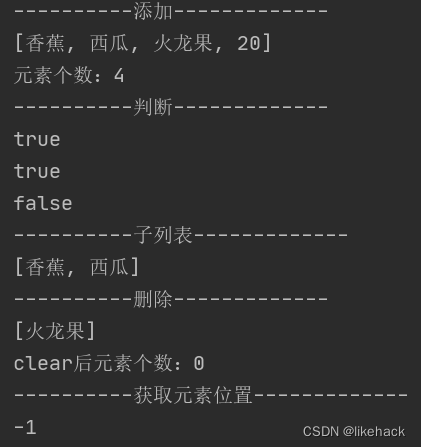
ArrayList
特点
- 数组结构实现,需要开辟连续的空间,查询快,增删慢
- jdk1.2版本引入,运行效率快,线程不安全
- 默认容量大小:DEFAULT_CAPACITY=10
- 没有添加元素时容量为0,size为0,添加元素以后,容量变为10,size等于实际添加的元素个数
- 存放元素的数组:Object[] elementData
案例
public class testArrayList {
public static void main(String[] args) {
ArrayList arrayList=new ArrayList();
Student s1=new Student("木头人",18);
Student s2=new Student("张学友",20);
Student s3=new Student("周杰伦",21);
//增加元素
addElement(arrayList, s1, s2, s3);
//遍历元素
traverseElement(arrayList);
//判断元素
judgeElement(arrayList, s1);
//查找元素
System.out.println("-------------查找----------");
System.out.println(arrayList.indexOf(new Student("张学友",20)));
//删除元素
// deleteElement(arrayList, s3);
}
//删除
private static void deleteElement(ArrayList arrayList, Student s3) {
System.out.println("-------------删除----------");
arrayList.remove(s3);
System.out.println(arrayList);
System.out.println("元素个数:"+arrayList.size());
arrayList.clear();
System.out.println("clear后元素个数:"+arrayList.size());
}
//判断
private static void judgeElement(ArrayList arrayList, Student s1) {
System.out.println("----------判断-------------");
System.out.println(arrayList.contains(s1));
System.out.println(arrayList.isEmpty());
}
//遍历
private static void traverseElement(ArrayList arrayList) {
System.out.println("-------------遍历----------");
//增强for
/*for (Object object:arrayList) {
Student s=(Student) object;
System.out.println(s.toString());
}*/
//迭代器
System.out.println("------迭代器--------");
Iterator iterator=arrayList.iterator();
while (iterator.hasNext()){
System.out.println(iterator.next());
// iterator.remove();
}
//使用列表迭代器
System.out.println("------列表迭代器--------");
//ListIterator可以从前或者从后开始遍历,添加,删除,修改元素
ListIterator listIterator=arrayList.listIterator();
System.out.println("------从前往后------");
while (listIterator.hasNext()){
System.out.println(listIterator.nextIndex()+":"+listIterator.next());
}
System.out.println("------从后往前------");
while (listIterator.hasPrevious()){
System.out.println(listIterator.previousIndex()+":"+listIterator.previous());
}
}
//添加
private static void addElement(ArrayList arrayList, Student s1, Student s2, Student s3) {
System.out.println("----------添加-----------");
arrayList.add(s1);
arrayList.add(s2);
arrayList.add(s3);
//List接口实现类,可重复添加元素
arrayList.add(s3);
System.out.println(arrayList);
System.out.println("元素个数:"+arrayList.size());
}
}
代码执行结果
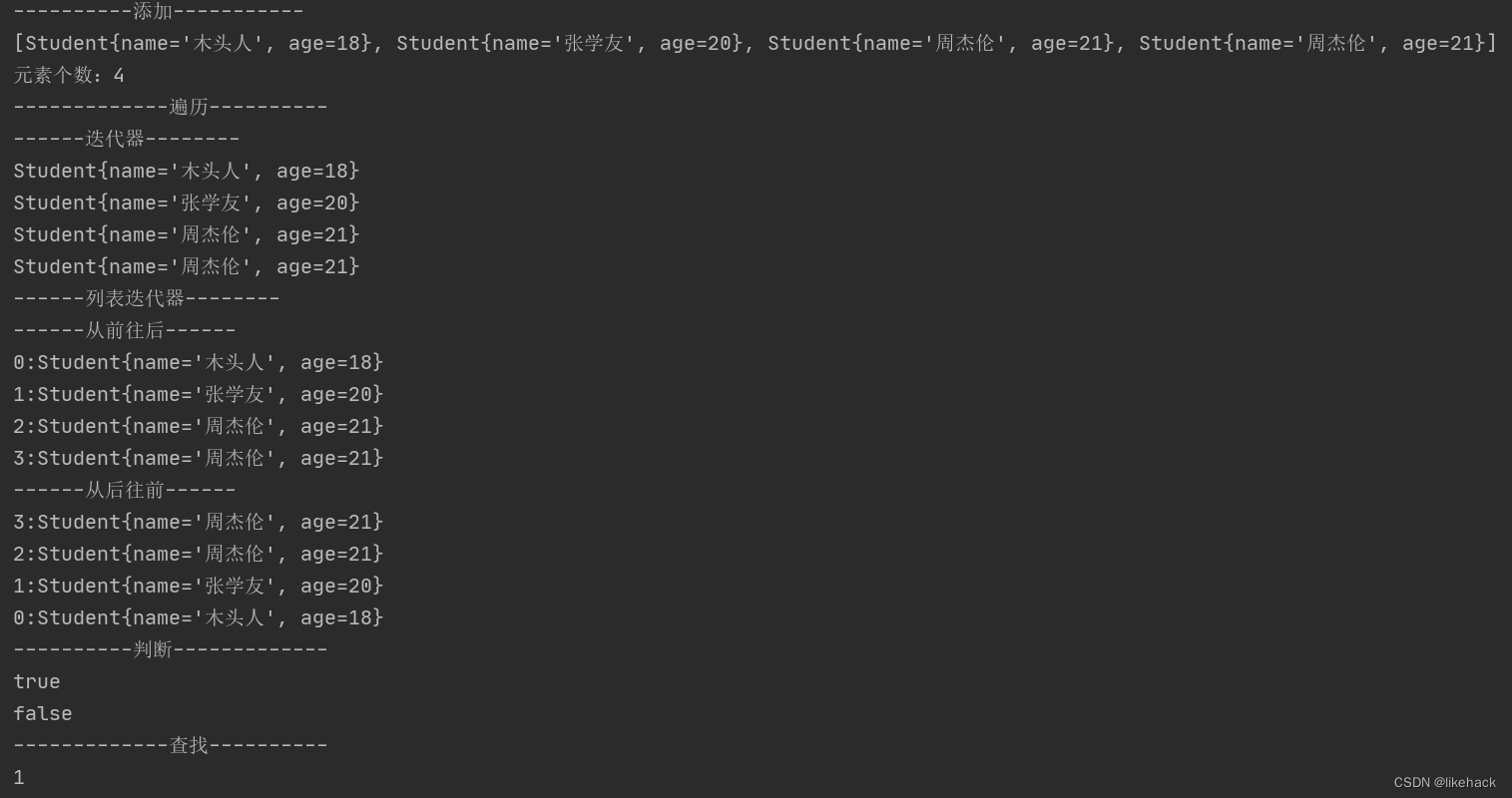
LinkList
特点
- 链表结构实现,不需要连续的空间,增删快,查询慢
案例
public class testLinkList {
public static void main(String[] args) {
LinkedList linkedList=new LinkedList();
Student s1=new Student("木头人",18);
Student s2=new Student("张学友",20);
Student s3=new Student("周杰伦",21);
//增加元素
addElement(linkedList, s1, s2, s3);
//遍历元素
traverseElement(linkedList);
//判断元素
judgeElement(linkedList, s1);
//查找元素
System.out.println("-------------查找----------");
//如果想要使用这中方法进行查找或者删除的话,需要重写Student的equals方法
System.out.println(linkedList.indexOf(new Student("张学友",20)));
//删除元素
deleteElement(linkedList, s3);
}
//删除
private static void deleteElement(LinkedList linkedList, Student s3) {
System.out.println("-------------删除----------");
linkedList.remove(s3);
System.out.println(linkedList);
System.out.println("元素个数:"+linkedList.size());
linkedList.clear();
System.out.println("clear后元素个数:"+linkedList.size());
}
//判断
private static void judgeElement(LinkedList linkedList, Student s1) {
System.out.println("----------判断-------------");
System.out.println(linkedList.contains(s1));
System.out.println(linkedList.isEmpty());
}
//遍历
private static void traverseElement(LinkedList linkedList) {
System.out.println("-------------遍历----------");
//增强for
// System.out.println("------增强for-------");
// for (Object object:linkedList) {
// System.out.println(object);
// }
//for循环
System.out.println("------for循环------");
for (int i=0;i<linkedList.size();i++) {
System.out.println(linkedList.get(i));
}
//迭代器
System.out.println("------迭代器---------");
Iterator it=linkedList.iterator();
while (it.hasNext()){
System.out.println(it.next());
// iterator.remove();
}
//使用列表迭代器
System.out.println("------列表迭代器--------");
//ListIterator可以从前或者从后开始遍历,添加,删除,修改元素
ListIterator listIterator=linkedList.listIterator();
System.out.println("------从前往后------");
while (listIterator.hasNext()){
System.out.println(listIterator.nextIndex()+":"+listIterator.next());
}
// System.out.println("------从后往前------");
// while (listIterator.hasPrevious()){
// System.out.println(listIterator.previousIndex()+":"+listIterator.previous());
// }
}
}
//添加
private static void addElement(LinkedList linkedList, Student s1, Student s2, Student s3) {
System.out.println("----------添加-----------");
linkedList.add(s1);
linkedList.add(s2);
linkedList.add(s3);
//List接口实现类,可重复添加元素
linkedList.add(s3);
System.out.println(linkedList);
System.out.println("元素个数:"+linkedList.size());
}
}
代码执行结果
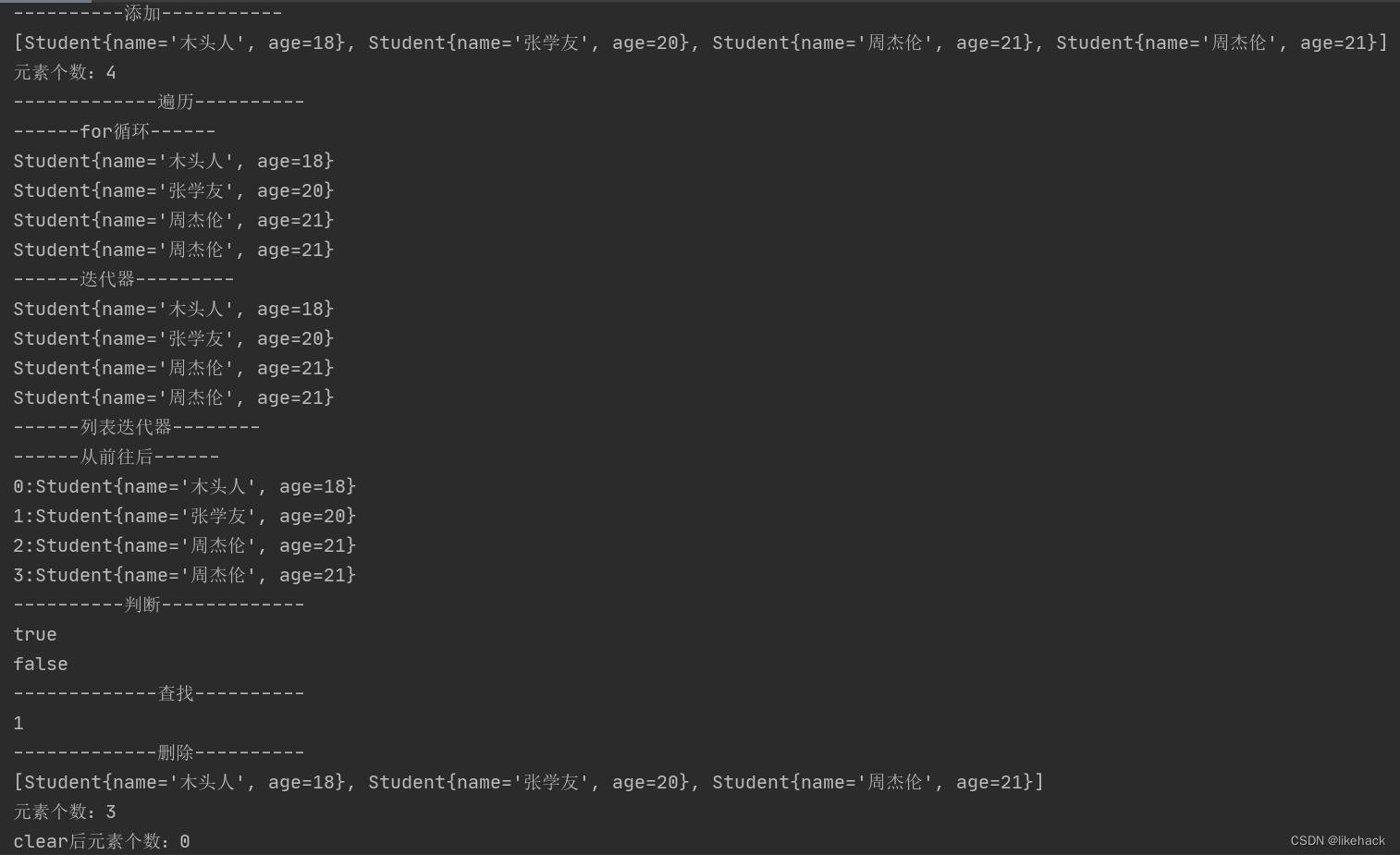
Vector
特点
- 数组结构实现,查询快,增删慢
- jdk1.0版本引入,运行效率慢,线程安全
案例
public class testVector {
public static void main(String[] args) {
Vector vector=new Vector();
Student s1=new Student("木头人",18);
Student s2=new Student("张学友",20);
Student s3=new Student("周杰伦",21);
//增加元素
addElement(vector, s1, s2, s3);
//遍历元素
traverseElement(vector);
//判断元素
judgeElement(vector, s1);
//
//查找元素
System.out.println("-------------查找----------");
System.out.println(vector.indexOf(new Student("张学友",20)));
//删除元素
deleteElement(vector, s3);
}
//删除
private static void deleteElement(Vector vector, Student s3) {
System.out.println("-------------删除----------");
vector.remove(s3);
System.out.println(vector);
System.out.println("元素个数:"+vector.size());
vector.clear();
System.out.println("clear后元素个数:"+vector.size());
}
//判断
private static void judgeElement(Vector vector, Student s1) {
System.out.println("----------判断-------------");
System.out.println(vector.contains(s1));
System.out.println(vector.isEmpty());
}
//遍历
private static void traverseElement(Vector vector) {
System.out.println("-------------遍历----------");
//增强for
/*for (Object object:vector) {
Student s=(Student) object;
System.out.println(s.toString());
}*/
//迭代器
System.out.println("------迭代器--------");
Iterator iterator=vector.iterator();
while (iterator.hasNext()){
System.out.println(iterator.next());
// iterator.remove();
}
//使用列表迭代器
System.out.println("------列表迭代器--------");
//ListIterator可以从前或者从后开始遍历,添加,删除,修改元素
ListIterator listIterator=vector.listIterator();
System.out.println("------从前往后------");
while (listIterator.hasNext()){
System.out.println(listIterator.nextIndex()+":"+listIterator.next());
}
// System.out.println("------从后往前------");
// while (listIterator.hasPrevious()){
// System.out.println(listIterator.previousIndex()+":"+listIterator.previous());
// }
}
System.out.println("------枚举器--------");
Enumeration en=vector.elements();
while (en.hasMoreElements()){
System.out.println(en.nextElement());
}
}
//添加
private static void addElement(Vector vector, Student s1, Student s2, Student s3) {
System.out.println("----------添加-----------");
vector.add(s1);
vector.add(s2);
vector.add(s3);
//List接口实现类,可重复添加元素
vector.add(s3);
System.out.println(vector);
System.out.println("元素个数:"+vector.size());
}
}
代码执行结果
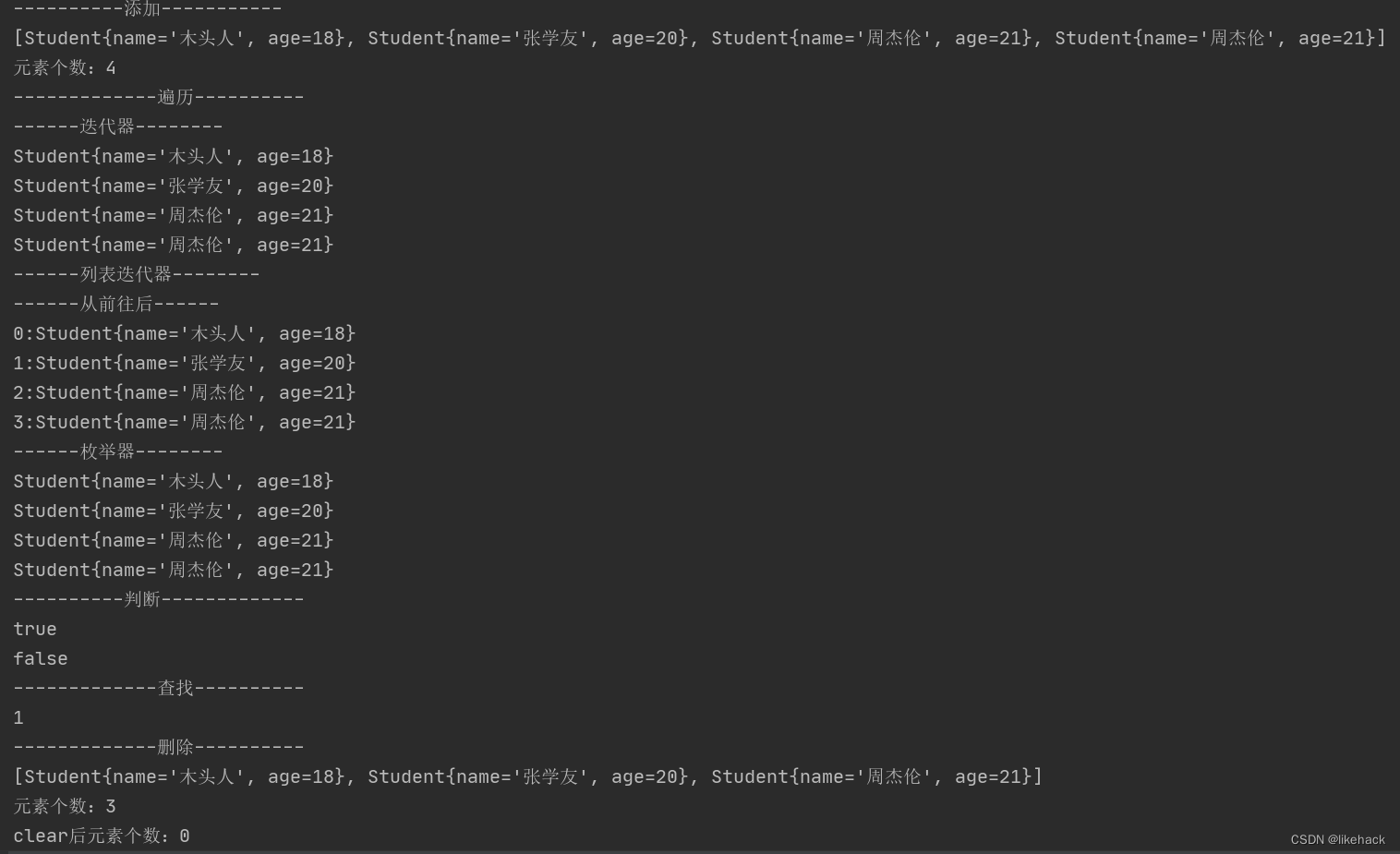
Set接口
特点: 无序,无下标,元素不可重复。
实现类: HashSet,SortedSet,TreeSet
案例
public class testSet {
public static void main(String[] args) {
Set<String> set=new HashSet<>();
addElement(set);
traverseElement(set);
judgeElement(set);
deleteElement(set);
}
private static void judgeElement(Set<String> set) {
System.out.println("----------判断-------------");
System.out.println(set.contains("李四"));
System.out.println(set.contains("木头人"));
System.out.println(set.isEmpty());
}
//遍历元素
private static void traverseElement(Set<String> set) {
System.out.println("----------遍历-------------");
//无序没有下标,所以不能使用常规for循环遍历
//增强for
System.out.println("------增强for------");
for (String string:set) {
System.out.println(string);
}
//使用迭代器
System.out.println("------迭代器------");
Iterator iterator=set.iterator();
while(iterator.hasNext()){
System.out.println(iterator.next());
//使用迭代器删除集合中的元素
// iterator.remove();
}
System.out.println(set.size());
}
private static void deleteElement(Set<String> set) {
set.remove("张三");
System.out.println(set);
//清空
set.clear();
System.out.println(set);
}
private static void addElement(Set<String> set) {
set.add("张三");
set.add("李四");
set.add("王五");
set.add("张三");
//[李四, 张三, 王五] 无序
System.out.println(set);
//元素个数:3 不可重复
System.out.println("元素个数:"+set.size());
}
}
代码执行结果

HashSet
特点
- 基于HashCode计算元素存放位置,存入元素哈希码相同时,通过equals确认元素是否相同,相同则拒绝后者进入
- 存储结构:哈希表(数组+链表+红黑树(红黑树是一种含有红黑结点并能自平衡的二叉查找树。))
- 存储过程:
(1)根据hashcode计算存储位置,为空,直接存入,不为空执行第二步
(2)执行equals方法,如果为true,元素重复,不存入;否则,形成链表
案例
HashSet存储字符串信息
public class testHashSet {
public static void main(String[] args) {
HashSet<String> set=new HashSet<>();
addElement(set);
traverseElement(set);
judgeElement(set);
deleteElement(set);
}
private static void judgeElement(Set<String> set) {
System.out.println("----------判断-------------");
System.out.println(set.contains("李四"));
System.out.println(set.contains("木头人"));
System.out.println(set.isEmpty());
}
//遍历元素
private static void traverseElement(Set<String> set) {
System.out.println("----------遍历-------------");
//增强for
System.out.println("------增强for------");
for (String string:set) {
System.out.println(string);
}
//使用迭代器
System.out.println("------迭代器------");
Iterator iterator=set.iterator();
while(iterator.hasNext()){
System.out.println(iterator.next());
//使用迭代器删除集合中的元素
// iterator.remove();
}
System.out.println(set.size());
}
private static void deleteElement(Set<String> set) {
System.out.println("------删除------");
set.remove("张三");
System.out.println(set);
//清空
set.clear();
System.out.println(set);
}
private static void addElement(Set<String> set) {
set.add("张三");
set.add("李四");
set.add("王五");
set.add("张三");
//[李四, 张三, 王五] 无序
System.out.println(set);
//元素个数:3 不可重复
System.out.println("元素个数:"+set.size());
}
}
代码执行结果
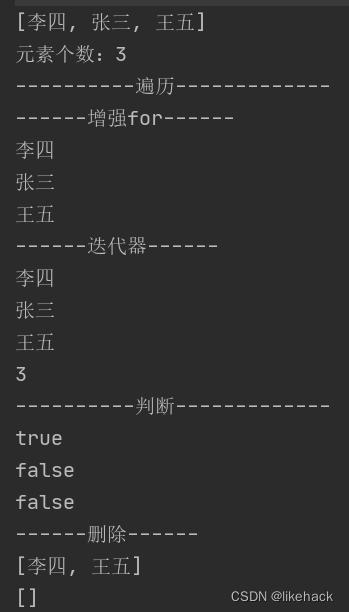
HashSet存储自定义类对象
public class testHashSetForStudent {
public static void main(String[] args) {
HashSet<Student> hashSet=new HashSet<>();
Student s1=new Student("小明",18);
Student s2=new Student("小红",20);
Student s3=new Student("小华",19);
Student s4=s1;
addStudent(hashSet, s1, s2, s3, s4);
traverseElement(hashSet);
judgeElement(hashSet, s1);
deleteElement(hashSet, s2);
}
private static void judgeElement(HashSet<Student> hashSet, Student s1) {
System.out.println("----------判断-------------");
System.out.println(hashSet.contains(s1));
System.out.println(hashSet.isEmpty());
}
private static void traverseElement(HashSet<Student> hashSet) {
System.out.println("-------------遍历------------");
//增强for
System.out.println("------增强for--------");
for (Object object:hashSet) {
Student s=(Student) object;
System.out.println(s.toString());
}
//迭代器
System.out.println("------迭代器--------");
Iterator iterator=hashSet.iterator();
while (iterator.hasNext()){
System.out.println(iterator.next());
// iterator.remove();
}
}
private static void deleteElement(HashSet<Student> hashSet, Student s2) {
System.out.println("----------删除---------");
hashSet.remove(s2);
hashSet.remove(new Student("小明",18));
System.out.println(hashSet);
hashSet.clear();
System.out.println(hashSet);
}
private static void addStudent(HashSet<Student> set1, Student s1, Student s2, Student s3, Student s4) {
System.out.println("----------添加---------");
set1.add(s1);
set1.add(s2);
set1.add(s3);
set1.add(s4);
set1.add(new Student("小明",18));
System.out.println(set1);
System.out.println("元素个数:"+set1.size());
}
}
代码执行结果
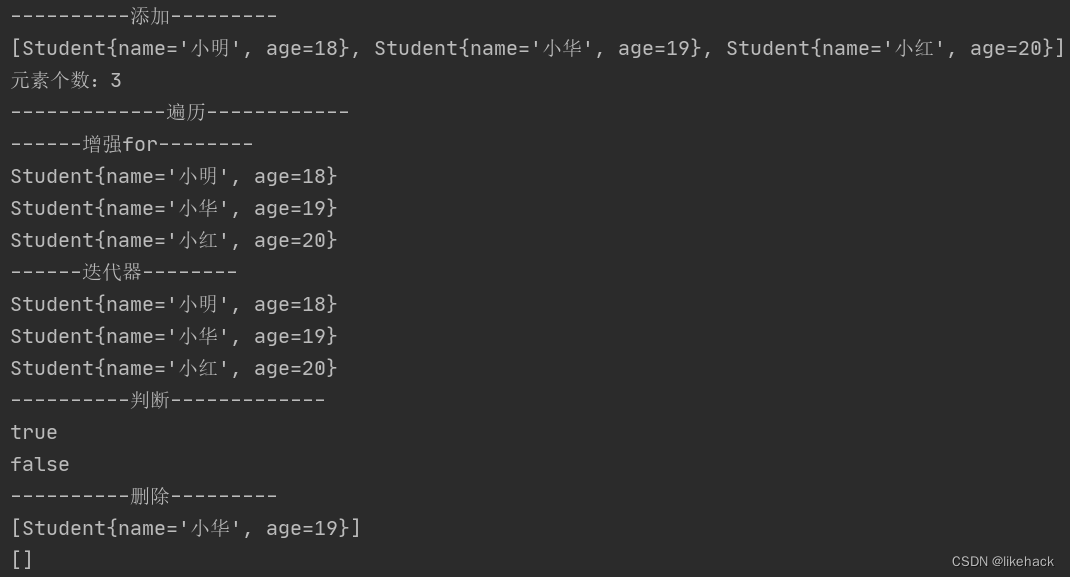
TreeSet
特点
- 基于排序顺序实现元素不重复
- 实现了SortedSet接口,对集合元素自动排序
- 元素对象的类型必须实现Comparable接口,指定排序规则
- 通过CompareTo来确定重复元素
案例
public class testTreeSet {
public static void main(String[] args) {
TreeSet<String> treeSet=new TreeSet<>();
addElement(treeSet);
traverseElement(treeSet);
judgeElement(treeSet);
deleteElement(treeSet);
}
private static void judgeElement(TreeSet<String> TreeSet) {
System.out.println("----------判断-------------");
System.out.println(TreeSet.contains("李四"));
System.out.println(TreeSet.contains("木头人"));
System.out.println(TreeSet.isEmpty());
}
//遍历元素
private static void traverseElement(TreeSet<String> TreeSet) {
System.out.println("----------遍历-------------");
//增强for
System.out.println("------增强for------");
for (String string:TreeSet) {
System.out.println(string);
}
//使用迭代器
System.out.println("------迭代器------");
Iterator iterator=TreeSet.iterator();
while(iterator.hasNext()){
System.out.println(iterator.next());
//使用迭代器删除集合中的元素
// iterator.remove();
}
System.out.println(TreeSet.size());
}
private static void deleteElement(TreeSet<String> TreeSet) {
System.out.println("------删除------");
TreeSet.remove("张三");
System.out.println(TreeSet);
//清空
TreeSet.clear();
System.out.println(TreeSet);
}
private static void addElement(TreeSet<String> TreeSet) {
TreeSet.add("李四");
TreeSet.add("张三");
TreeSet.add("王五");
TreeSet.add("张三");
//[李四, 张三, 王五] 无序
System.out.println(TreeSet);
//元素个数:3 不可重复
System.out.println("元素个数:"+TreeSet.size());
}
}
代码执行结果
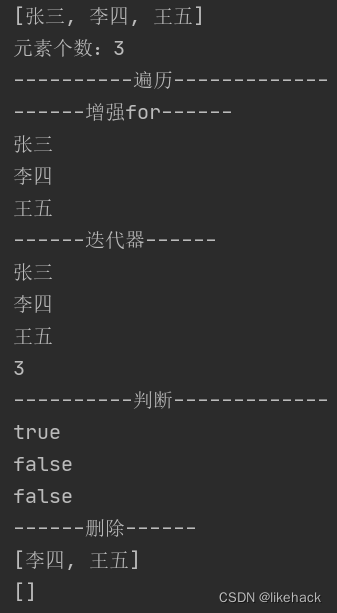
指定排序规则有两种方法:
- 自定义类对象实现Comparable接口,指定排序规则(见Student类中的compareTo方法)
- 创建集合时指定排序规则
public class testTreeSetForStudent {
public static void main(String[] args) {
TreeSet<Student> treeSet=new TreeSet<>();
Student s1=new Student("小明",18);
Student s2=new Student("小红",20);
Student s3=new Student("小华",19);
Student s4=new Student("小华",20);
addStudent(treeSet, s1, s2, s3, s4);
traverseElement(treeSet);
judgeElement(treeSet, s1);
deleteElement(treeSet, s2);
//创建集合并指定比较规则
TreeSet<Student> students=new TreeSet<>(new Comparator<Student>() {
@Override
public int compare(Student o1, Student o2) {
int n1=o1.getAge()-o2.getAge();
int n2=o1.getName().compareTo(o2.getName());
return n1==0?n2:n1;
}
});
System.out.println("===========指定比较规则后======");
addStudent(students, s1, s2, s3, s4);
traverseElement(students);
judgeElement(students, s1);
deleteElement(students, s2);
}
private static void judgeElement(TreeSet<Student> treeSet, Student s1) {
System.out.println("----------判断-------------");
System.out.println(treeSet.contains(s1));
System.out.println(treeSet.isEmpty());
}
private static void traverseElement(TreeSet<Student> treeSet) {
System.out.println("-------------遍历------------");
//增强for
System.out.println("------增强for--------");
for (Object object:treeSet) {
Student s=(Student) object;
System.out.println(s.toString());
}
//迭代器
System.out.println("------迭代器--------");
Iterator iterator=treeSet.iterator();
while (iterator.hasNext()){
System.out.println(iterator.next());
// iterator.remove();
}
}
private static void deleteElement(TreeSet<Student> treeSet, Student s2) {
System.out.println("----------删除---------");
treeSet.remove(s2);
treeSet.remove(new Student("小明",18));
System.out.println(treeSet);
treeSet.clear();
System.out.println(treeSet);
}
private static void addStudent(TreeSet<Student> treeSet, Student s1, Student s2, Student s3, Student s4) {
System.out.println("----------添加---------");
treeSet.add(s1);
treeSet.add(s2);
treeSet.add(s3);
treeSet.add(s4);
treeSet.add(new Student("小明",18));
System.out.println(treeSet);
System.out.println("元素个数:"+treeSet.size());
}
}
代码执行结果
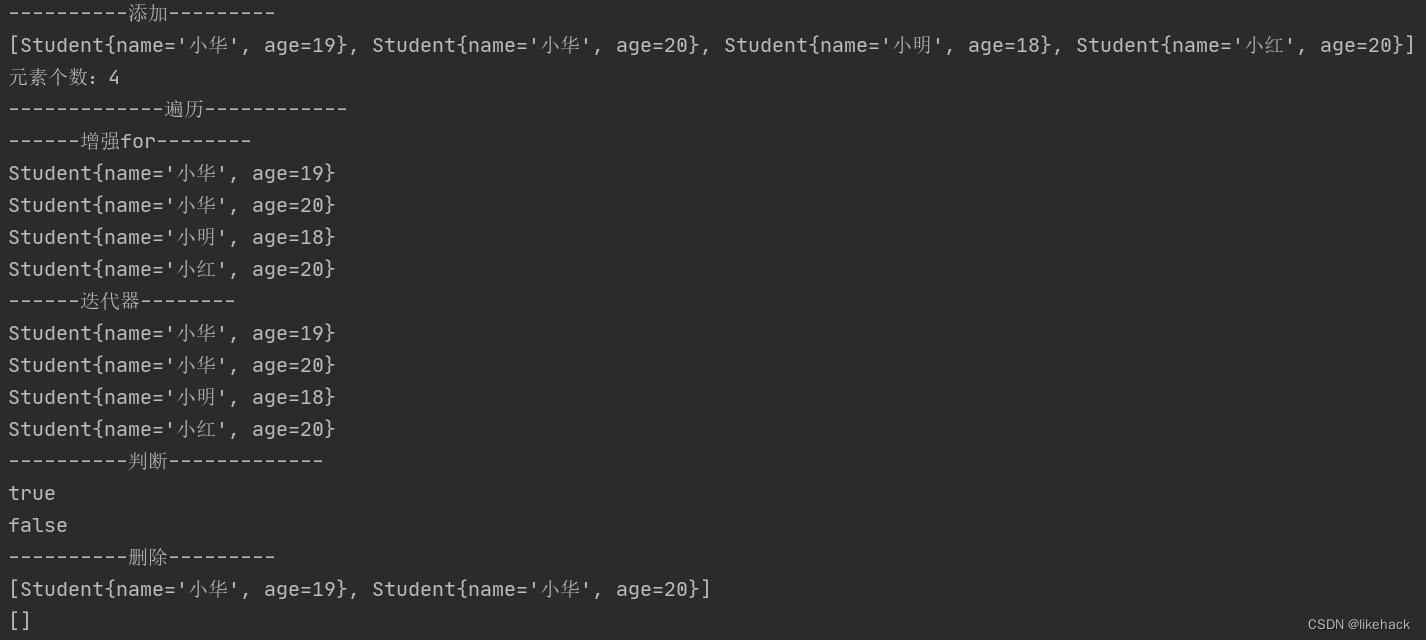
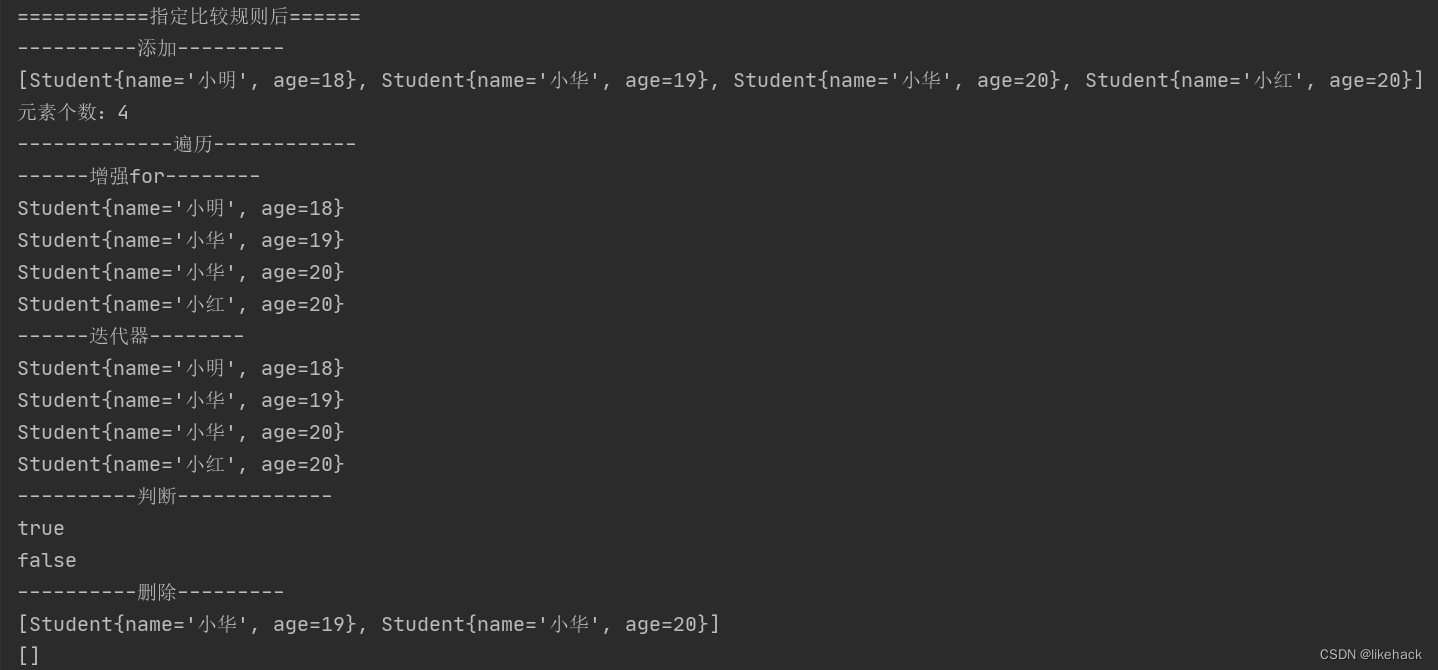
其他相关文章
- Java知识梳理:Java知识梳理
- Java知识梳理–内部类:Java知识梳理–内部类
- Java常用类–Object类:Java常用类–Object类
- Java常用类–包装类:Java常用类–包装类
- Java常用类–String类:java常用类–String类
- Java常用类–时间相关类:Java常用类–时间相关类
- Java常用类–BigDecimal类和System类:Java常用类–BigDecimal类和System类

























 157
157











 被折叠的 条评论
为什么被折叠?
被折叠的 条评论
为什么被折叠?










